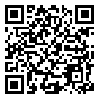BibTeX | RIS | EndNote | Medlars | ProCite | Reference Manager | RefWorks
Send citation to:
URL: http://journal.zums.ac.ir/article-1-3091-en.html
2- Biology Research Center, Islamic Azad University, Zanjan Branch, Zanjan, Iran ,
3- Biology Research Center, Islamic Azad University, Zanjan Branch, Zanjan, Iran
Background and Objective: Staphylococcus aureus is an important pathogen causing a wide range of infections in hospitals and is known due to its resistance to antibiotics. Novel methods of nanotechnology and the effective combination of different antimicrobial mechanisms can be compelling approaches to treat infectious diseases. The aim of this study was to investigate the antimicrobial effect of silver nanoparticles, allicin and their combination on skin infections due to Staphylococcus aureus in mouse model. Materials and Methods: Minimum inhibitory concentration (MIC) and minimum bactericidal concentration (MBC) of silver nanoparticles, allicin and their combinations were measured based on the microdilution susceptibility test. Skin infection was induced in 20 Syrian mice with Staphylococcus aureus and the effect of silver nanoparticles, allicin along with the synergistic effect of allicin as well as silver nanoparticle combinations were investigated. Results: The results showed that minimum inhibitory concentration and minimum bactericidal concentration of silver nanoparticle for S. aureus were 6.25 and 12.5 ppm, respectively. MIC and MBC of allicin for S. aureus were 10.68 and 21.37μg/ml, respectively. MIC and MBC combination of allicin and silver nanoparticles on S. aureus were 1.33 μg/ml, 3.12 ppm and 2.67 μg/ml, 6.25 ppm, respectively. Anti microbial effect of allicin, silver nanoparticles and the synergistic effect of their combination against skin infections due to Staphylococcus aureus confirmed in mouse model. Conclusion: The results showed that allicin in combination with silver nanoparticles exhibit synergistic effect on skin infections due to Staphylococcus aureus. References 1- Mccaig F, Clifford Mcdonald L, Mandal S, Jernigant B. Staphylococcus aureus associated skin and soft tissue infections in ambulatory care. Emerg Infect dis. 2006 12: 1715-23. 2- Harris G, Foster J, Richards G. An introduction to Staphylococcus aureus, and techniques for identifying and quantifyings S. aureus Adhesins in relation to adhesion to biomaterials: review. Eur cells Material. 2002 4: 29-60. 3- Uwazuoke J, Aririatu L. A survey of antibiotic resistant Staphylococcus aureus strains from clinical sources in Owerri. J Appl Sci Environ. 2004 8: 67-69. 4- Kokoska L, Polesny Z, Rada V, et al. Screening of some Siberian medicinal plants for antimicrobial activity. J Ethanopharmacol. 2002 82: 51-53. 5- Kathi J, Kemper M. Garlic (Allium sativum). Longwood Herbal Task Force. 2000: 1-49. 6- Aala F, Yusuf U, Jamal F, Rezaie S. Antimicrobial effects of allicin and ketoconazole on Trichophyton rubrum under in vitro condition. Braz J Microbiol. 2012: 786-92. 7- Culter R, Wilson P. Antibacterial activity of a new, stable, aqueous extract of allicin against methicillin-resistant Staphylococcus aureus. Br J Biomed Sci. 2004 61: 1-4. 8- Cai Y, Wang R, Pei F, Liang B. Antibacterial activity of allicin alone and in combination with b -Lactams against Staphylococcus spp. And Pseudomonas aeruginosa. J Antibiot. 2007 60: 335-38. 9- Shahnaz A, Javed K, Nasim A. Study of synergistic effect of allicin with antibacterials against micro-organisms. J Annals. 2009 15: 138-40. 10- Chung I, Kwon S, Shim S, Kyung K. Synergistic antiyeast activity of garlic oil and allyl alcohol derived from alliin in garlic. J Food Sci. 2007 72: 437-40. 11- Heydarnejad M, Yarmohammadi-Samani P, Mobini- Dehkordi M, Rahnama S. The influence of topical treatment of dermal wounds with silver nanoparticles on ALT and AST enzymes and hemoglobin in mice (Mus Musculus). J Zanjan univ Med Sci. 2011 21: 35-44. 12- Arbabi Bidgoli S, Mahdavi M, Rezayat M, Korani M, Amani A, Ziarati P. Toxicity assessment of nanosilver wound dressing in wistar rat. Acta Medica Iranica. 2013 51: 203-8 13- Dabbagh MA, Moghimipour E, Ameri A, Sayfoddin N. Physicochemical characterization and antimicrobial activity of nanosilver containing hydrogels. Iran J Pharm Res. 2008 7: 21-8. 14- Ping Li, JuanLi, ChangzhuWu, et al. Synergistic antibacterial effects of β-lactam antibiotic combined with silver nanoparticles. Nanotechnology. 2005 16: 1912-17. 15- Marambio-Jones C, Hoek EMV. A review of the antibacterial effects of silver nanomaterials and potential implications for human health and the environment. J Nanopart Res. 201012: 1531-51. 16- Delaha EC, Garagusi VF. Inhibition of mycobacteria by garlic extract (Allium sativum). Antimicrob Agents Chem. 1985 27: 485-6. 17- Kora AJ, Arunachalam J. Assessment of antibacterial activity of silver nanoparticles on Pseudomonas aeruginosa and its mechanism of action. World j microbbi biotechnlo. 2011 27: 1209-16. 18- Mohsen nezhad F, Zeighami H, Mota A, et al. Antibacerial activity of eukalyptus extracts on methicillin resistance Staphylococcus aureus. Res J biol Sci. 2009 4: 905-8. 19- Dai T, Tegos GP, Zhiyentayev T, et al. Photodynamic therapy for methicillin resistant Staphylococcus aureus Infection in a mouse skin abrasion model. Laser Surg Med. NIH-PA Author Manuscript. 2010 42: 38-44. 20- Naeini A, Khosravi A, Tadjbakhsh H, et al. Evaluation of the immunostimulatory activity of Ziziphora tenuior extracts. Comp Clin Pathol. 2010 19: 459-63. 21- Ansari MA, Khan HM, Khan AA, et al. Evaluation of antibacterial activity of silver nanoparticles against MSSA and MRSA on isolates from skin infections. Biol Med. 2011 3: 141-6.
Received: 2015/04/28 | Accepted: 2015/04/28 | Published: 2015/04/28
| Rights and permissions | |
 |
This work is licensed under a Creative Commons Attribution-NonCommercial 4.0 International License. |




